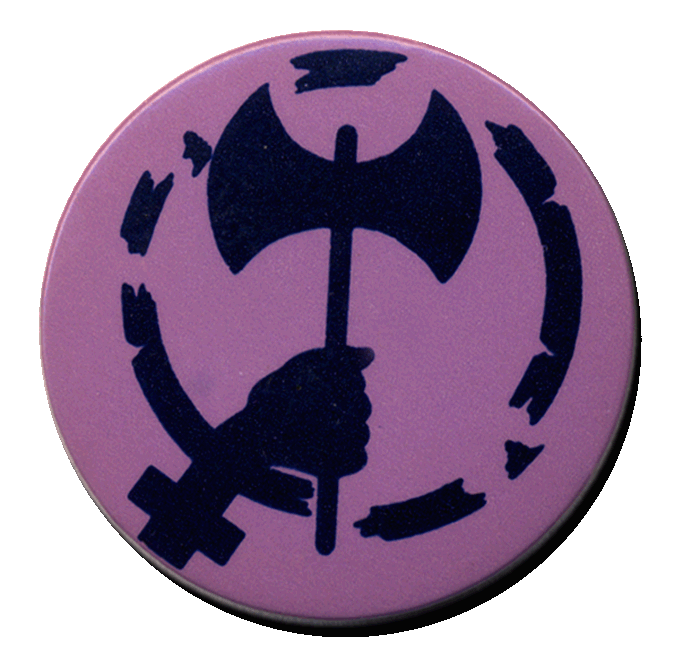EMMA and Courage are published. For the first time ever, feminists have a supra-regional, public voice. The formerly united women’s movement starts differentiating itself into different political tendencies.
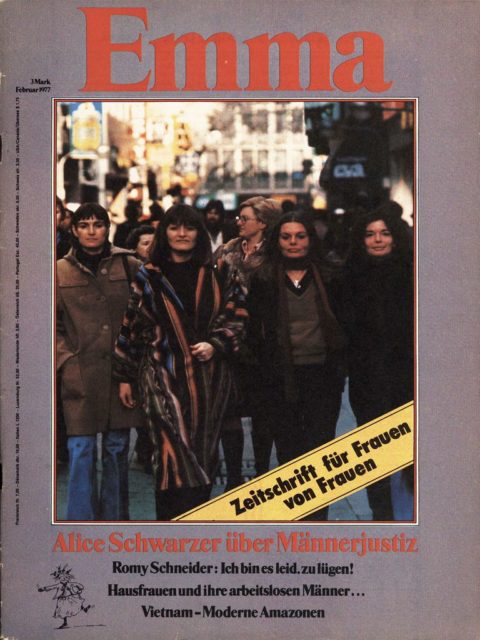
21-23rd January 1977
Eleven women’s groups [Frauenreferate] from German universities are holding their first central meeting in Frankfurt/Main.
January 26, 1977
The first issue of EMMA is published. The first edition of 200,000 is sold out in a short time, as well as the reprinted 100,000 copies. The editor of the magazine by women for women is Alice Schwarzer. In addition to Schwarzer, journalists Sabine Schruff and Angelika Wittlich, who are both permanently employed elsewhere, are also working in Cologne’s editorial office. The only full-time employee is editorial secretary Christiane Ensslin (who has virtually been punished for the mistakes of her sister Gudrun Ensslin and has therefore been unemployed until then).

The magazine is not only exposed to the malice of the male media (Spiegel) in advance but is also faces hostility from parts of the feminists. The criticism is ignited by the ‚commerciality‘ of the project and the (false) insinuation that EMMA belongs to the Gruner & Jahr publishing house. The women’s magazine Courage calls for a boycott of information a few months before the first publication of the EMMA. The Schwarze Botin claims that „market-friendly journalism and the interests of the women’s movement“ are „incompatible“ and announces: „In January, 200,000 women are to be penetrated“ (which is an allusion to the concept of sexual ‚penetration‘, that has previously been described by Schwarzer in Der kleine Unterschied)“.

In contrast to Courage, which is intentionally made by non-professional women and focuses more on feminist specific contexts in terms of language and content, EMMA sees itself as a professional magazine that wants to position itself on the general magazine market. EMMA represents the radical feminist position, which assumes that there is no „natural“ difference between the sexes. In 1981 the EMMA circulation leveled off at 100,000. – Alice Schwarzer looking back on the founding years: ‚EMMA lebt – und wenn die Jungs sich totärgern‘ (EMMA 2/87)
In the first issue of EMMA, Virginia Woolf (1882-1941) is portrayed. From a literary and political point of view, the Englishwoman is the most important feminist writer of the 20th century alongside Simone de Beauvoir. Her works were completely out of print in German at the time. The young feminists rediscover this hitherto ignored mastermind. A short time later the Fischer-Verlag starts a reedition of most of her works and since 1989 gradually publishes Woolf’s complete works in an excellent re-translation.
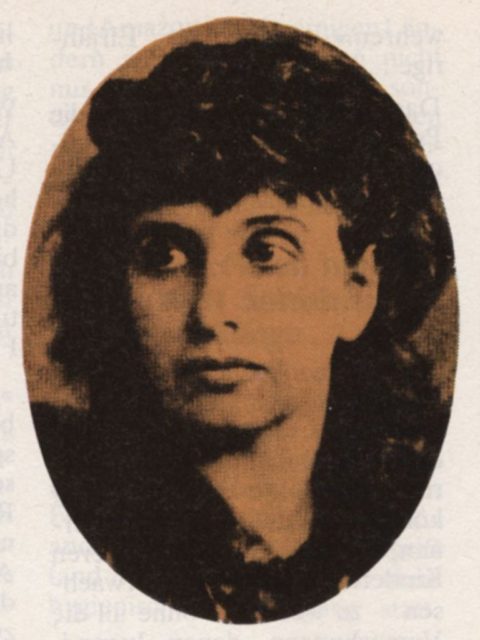
In the following issue Hedwig Dohm (1831-1919) is portrayed. She is the most brilliant and polemical author of the Historical Women’s Movement and was a famous woman in her day. Nevertheless, she was completely forgotten, her works burned on the book-pyre of the Nazis. The young feminists discover their hitherto ignored predecessors
In the first EMMA issue Alice Schwarzer wrote about „Männerjustiz“ [male bias of the judiciary], a term in the style of the concept of „Klassenjustiz“ [class bias of the judiciary]. She explains the extent to which the murder of women for reasons of „male honour“ was treated by the judiciary as a trivial offense, and how the biased judiciary applied double standards to male offenders and female victims. – The first German lawyer, Anita Augspurg (1857-1943) had already coined this term at the beginning of the twentieth century – but that had been forgotten and was only rediscovered in the 1980s.
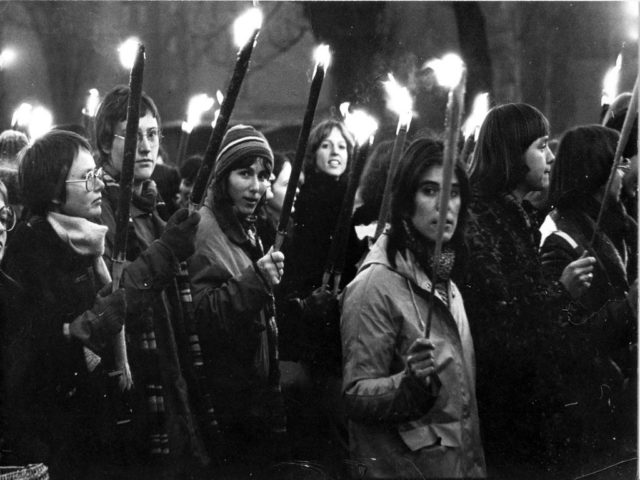
March 1, 1977
For the first time women organize a night demonstration against sexual violence in Berlin. Reason: In Charlottenburg, the 26-year-old Susanne Schmidtke was raped and then so badly beaten up that she died three weeks later. The flyer on the demonstration states: „In Germany, 35,000 women are raped every year, which means that every fifteen minutes a woman is raped. Of these rapes 7,000 are reported to the police but only 700 rapists are issued with a final sentence (0.5%). The silence about rape needs to be broken! “
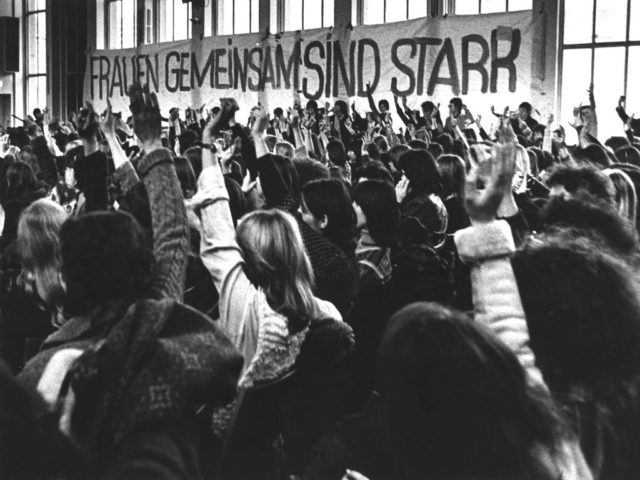
5th 6th March 1977
At the ‚National Women’s Congress of the Autonomous Women’s Movement‘ in Munich, around 800 participants discuss the work in their booming projects. The represented projects range from the Cafégruppe Frankfurt to the Berlin Initiativgruppe Arbeitslosigkeit [unemployment group] to the founders of the Berlin women’s shelter. The topics range from violence to ecology to art. The issue of sexual violence against women is becoming increasingly important. The participants decide to organize nationwide night demonstrations on the night of May 1 – the ‚Walpurgis Night‘. Motto: ‚Women take back the night!‘

However, with the boom in women’s projects first conflicts appear. Thus, the organizers of the ‚National Women’s Congress‘ in Munich resignedly draw the conclusion: „The leap into the world of business, even if it is about women’s businesses, has not taken place without causing damage. (…) One boycott follows the next and substantial discussions have decreased. Today, it’s all about the bargaining of percentages and about not being cheated by the sister project. Competition and power struggle between women are so rampant that we have not found a woman who was willing to say a few coherent sentences on women’s projects.“
6th-8th March 1977
In Berlin, the exhibition ‚Women in Art‘ takes place. A group of feminists, in collaboration with the Neuen Gesellschaft für bildende Kunst [New Society for the Visual Arts], present international artists such as Magdalena Abakanowicz, Giorgia O’Keeffe and Meret Oppenheim. And asks the question: „Is there a feminine aesthetic?“
The next exhibition on the subject takes place at the end of April in Frankfurt/Main titled „Women Artists International 1877-1977“. The group Frauen in der Kunst [Women in the Arts] has compiled the works and biographies of 182 artists from 100 years under the umbrella of the Frankfurter Kunstverein. The ‚Ausbruch der Frauen‘ (Frankfurter Rundschau) is now also beginning in the arts, which has previously been reserved to „creative, ingenious“ men.
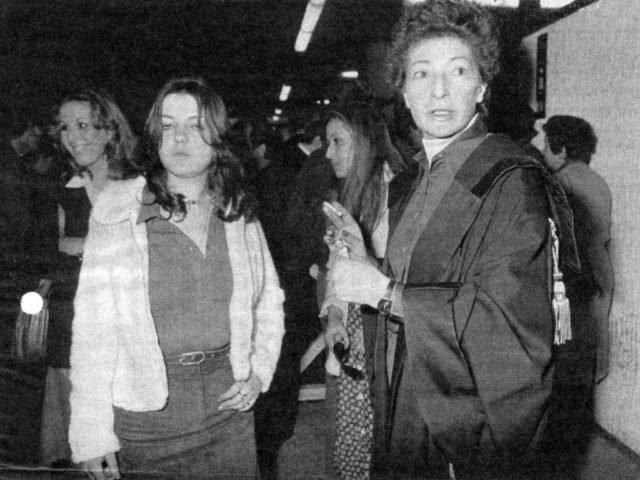
Early April 1977
In Italy, the case of Claudia Caputi brings thousands of women to the streets. The 18-year-old Claudia has been raped in Milan by 16 young men. She reports the rape to the police. Although the perpetrators are threatening and intimidating her during the trial, the prosecution does not impose any protective measures. The victim is raped again and injured with razor blades.
Claudia Caputi becomes a symbolic figure for the Movimento per la Liberation of the Donna (MLD). In Germany, where women’s groups are increasingly addressing the extent of sexual violence and the growing number of gang rapes, the case is causing a stir.

April 6, 1977
In response to a sexist cover of the magazine konkret, the women’s group Militante Panther-Tanten closes the Hamburg editorial offices with masonry. In the cover story, ‚Feminismus 77 – Schwach auf der Brust’, three authors and one female author accuse feminists of ignoring the class question: „The consequences of this construct of a class neutral patriarchy are either cynical or reactionary, at best stupid.“ The formerly moderate to sympathetic tone of the left press with regard to the women’s movement becomes increasingly violent: „One would like to gather all of one’s left-wing chauvinism to have it off with these Emmas.“
Even in the ‚bourgeois media‘, the initially benevolent reporting changes in the light of the persistence and radicalism of the women’s movement. Typical headlines read: „Feminism varies between hatred and self-hatred“ or „Women’s movement finished?“
April 11, 1977
In the Spiegel, an article titled ‚Feminism: Emma with the crown of thorns‚ appears, which does not save with polemic, but nevertheless reflects the Zeitgeist precisely. This portrays how a growing part of the women’s movement gets engulfed in the „new femininity“, „new inwardness“ and new esotericism. „Half mater dolorosa, half guardian of the secrecy of the world, the woman, the unrecognized being, was flowing through Verena Stefan’s novel, Häutungen,“ it says. And because of a Romy-Schneider portrait, EMMA gets her come-uppance as „suddenly inspired by the feminine ideal of Hedwig Courths-Mahler“. Is political feminism threatened of sinking into self-pity and complacency?
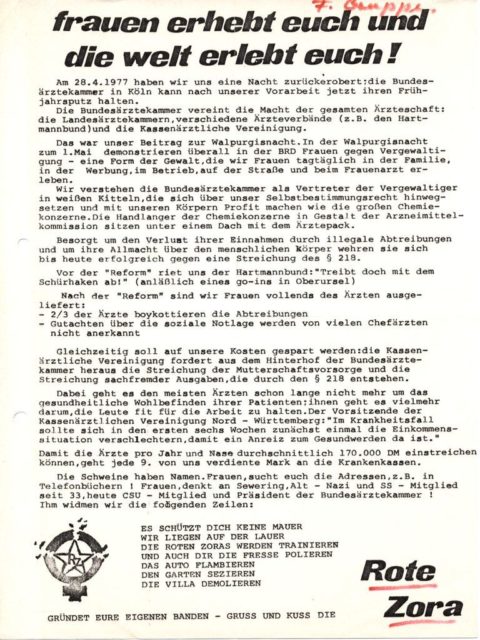
April 21, 1977
At Frauenhof Graiganz, historians take part in the first nationwide meeting on ‘women in history’. Feminists now also discover history as an issue for women’s studies. A year later, Berlin will host the first ‚Historikerinnentreffen‘ in Berlin.
April 28, 1977
The Rote Zora perpetrates an explosive attack on the building of the German Medical Association. („We understand the German Medical Association as the representative of the rapists in white coats who override our right to self-determination!“) It is considered the first attack of the militant women’s group, which on the one hand sees itself as part of the Revolutionary cells, but on the other hand feels committed to the goals of the women’s movement. It turns out that the attack on the Federal Constitutional Court in 1974 already goes to the account of the Rote Zora. The reason was the tipping of the ‚Fristenlösung‘ by the constitutional judge. The group perpetrated attacks against sex shops, women traffickers or porn cinemas until the 1980s, but always limited itself to damage to property. Motto: ‚Women, rise! And the world will experience you!‘
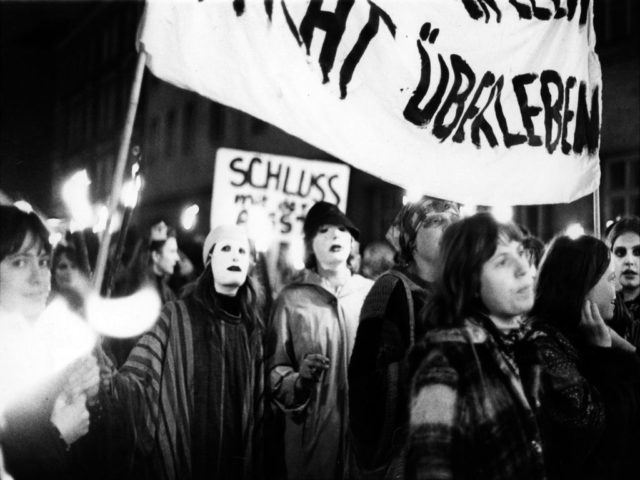
April 30, 1977
Thousands of women take to the streets on rape and sexual harassment on ‘Walpurgis Nacht’ (The Witches‘ Night on Blocksberg). Motto: „Women take back the night!“ Throughout Germany, women demonstrate with torches, candles and white painted faces against the daily threat: „Curfew in the dark is the fate of being female!“
May 1977
In Cologne, the first congress on feminist therapy takes place: ‚feminism and psychoanalysis‘. The topics range from the ‚mother-daughter relationship‘ to ‚female masochism‘ to ‚anorexia‘.
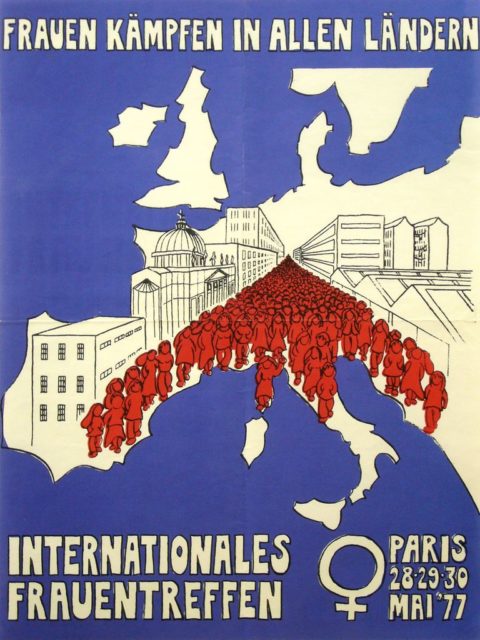
Pentecost 1977
Around 4,000 women from all over the world come to the International Women’s Meeting in Paris. French women’s groups that call themselves the „class struggle movement within the women’s liberation movement“ have made the invitation. The congress reveals the gap between the radical feminists and the initiators, whose stated goal is „to unify the struggles of women and make them become part of the labor movement.“
A similar conflict is revealed at a second women’s congress in early June in Amsterdam. Courage complains: „We did not get beyond the piece of Tesafilm, with which feminism was glued to socialist theory.“
14th-16th June 1977
More than 200 women from Europe, the USA, South America and Australia meet in Rome for the First International Women’s Health Congress.
July 1, 1977
The new marriage law comes into force. With the ‚First Law for the Reform of Marriage and Family Law‘ the ‚housewife marriage‘ is abolished. To that date, the wife was „obliged to housekeeping“. She was only allowed to work if she did not neglect her „family responsibilities“, her husband was allowed to terminate his wife’s employment contracts without her consent. At the same time, wives were obliged to unpaid participation in the profession or business of the man.
These core elements of ‚family law‘ had not been significantly changed since its incorporation into the Civil Code in 1900. Thus, the law which gave the husband the „decision in all matters concerning the life of the community“ had already been sharply criticized by the Historical Women’s Movement. (Anita Augspurg: Ein typischer Fall der Gegenwart ; Louise Dittmar: Für die Entfaltung der weiblichen Persönlichkeit)
With the new marriage law, spouses now have to settle the „housekeeping by mutual agreement“. Women also have the right to work, and men must also take „family responsibilities“ into account. The unpaid obligation to work is suspended. The divorce law is also being reformed: the guilt principle has been abolished. So far divorced people had no right to maintenance – for example, wives who had neglected their ‚family responsibilities‘.
Zeit comments: „If it were only by law, then wives would have the choice between household, occupation or a combination of both. In practice, they usually do not have these choices: their education is bad, their job prospects are bad, their pay would be bad, and their self-esteem is at least cracked after a few years of household and family isolation. A change will take more time than changing the Civil Code. “

July 23, 1977
For the first time in the history of German press, the German Press Council issued a reprimand for sexism. Reason: A Spiegel cover. The headline ‚Children in the Sex Market – The Sold Lolitas‘ is illustrated with the photo of a 12-year-old naked girl clothed as prostitute. EMMA, Courage, Unsere kleine Zeitung and the Kinderschutzbund make a protest at the Press Council: „An image that would as such be offered in a pornographic publication is in this case subject of mockery and morally masked.” The German Press Council reprimands.
Summer / Autumn 1977
The ‚Deutsche Herbst’[German Autumn]. Given the high number of female terrorists – such as Ulrike Meinhof, Susanne Albrecht or Gudrun Ensslin – who are involved in attacks and kidnappings, the press muses on the connection of feminism and terrorism. The Spiegel headlines: „The Terrorists – Women and Violence“ and states: „Among West Germany’s terrorists, girls are now in the majority. Excess of emancipation?“ – „Does emancipation make women become terrorists?“, asks Brigitte. And the world blames a „certain kind of feminism“ for the high proportion of women among the terrorists.
In EMMA, Alice Schwarzer analyzes the press coverage as a „defamation of the emancipation movement“. A Frankfurt women’s group composes the satirical appeal to all women for the Erfindung des Glücks [invention of happiness].

September 1977
Throughout Germany, ‘groups of activists against clitoral circumcision‘ are founded. After EMMA was first to report on this previously ignored human rights violation to millions of girls and women in March, the editors were „overrun“ with letters. Activists put forward their protest against the „millionfold massacre“ to the World Health Organization, UN, the Ministry of Development and other authorities. The feminist protest against genital mutilation is also forming up internationally.
16.-18. September 1977
For the first time, groups from the autonomous women’s movement and traditional women’s associations come together for a joint event: the ‚Berlin Women’s Conference‘. The impetus and funding come from the European Community, which wants to inform women’s groups about the EC on the occasion of the forthcoming elections to the European Parliament. Thus, the contact between autonomous women and traditional women is initially characterized by mutual distrust. The Women’s Committee of the DGB, the Working Group of Social Democratic Women (AsF) and other traditional women’s associations announce their official participation, but many members still take part unofficially.
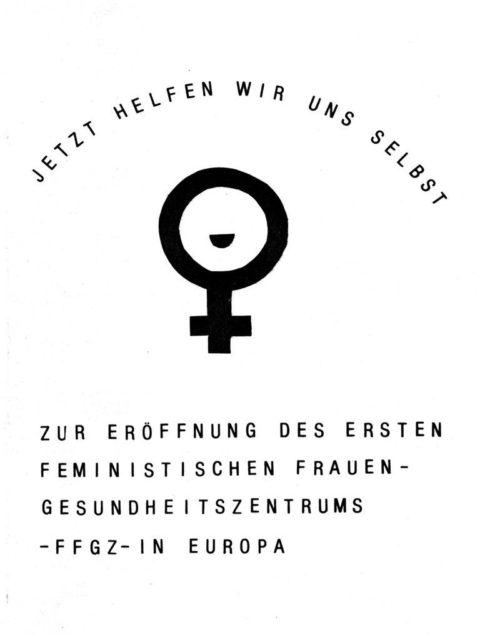
October 1977
Three years after the first demonstration of a vaginal self-examination by the American Carol Dawner in the Berlin Women’s Center, Europe’s first Feminist Women’s Health Center (FFGZ) opens in Berlin. The center, in which a doctor, a nurse and a medical-technical assistant work, sees itself as an alternative to the traditionally „male-dominated“ gynecology. The FFGZ relies on a holistic concept of health and a self-determined way of dealing with one’s own body: „Through self-help, we want to put ourselves in a position to determine our own body and our sexuality.“
The center provides guidance on smears and self-examination via speculum, informs about contraception issues and abortions. The reaction of the medical profession follows on the foot: The Deutsches Ärzteblatt associates the burgeoning women’s health initiatives with the „terror scene“. A year later another FFGZ is opened in Frankfurt. Hamburg, Bremen and Hannover are to follow. Today there are 18 Feminist Women’s Health Centers in Germany.
The opening of the Berlin FFGZ in October 1977 stands in the tradition of the Historical Women’s Movement: Exactly one hundred years earlier, the doctors Franziska Tiburtius and Emilie Lehmus opened the first German ‚Policlinic of Female Doctors for Women and Children‘ on Schönhauser Strasse.
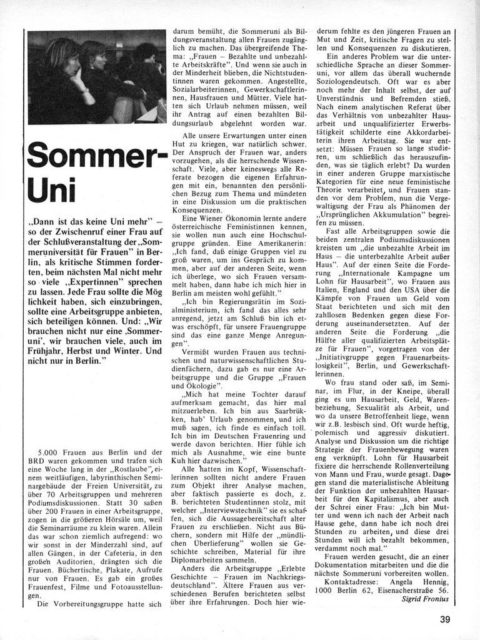
3th-8th October 1977
5,000 women take part in the 2nd Summer University in Berlin. The main topic: ‚Women – Paid and unpaid labor‘. Almost all the 70 working groups revolve around „unpaid work in the house – underpaid work outside the home“. The issue of ‚wages for housework‘ continues to be a hot topic.
28th-30th October 1977
In Cologne, around 160 women come together for the ‚National Meeting of Lesbians‘. Topice: ‚Dauntless Lesbian Policy – How Can We Bring Lesbian Politics to the Public?‘
November 1977
The literary symposium, which takes place during the Steirischer Herbst in Graz, is entitled: ‚Men’s Language – Women’s Language – Women’s Literature – Men’s Literature‘. Seven years before Luise Pusch will expose the German as male language, the German journalist Marielouise Janssen-Jurreit explains (sexism) in Graz: „A woman can find her identity harder and harder to express, because the language reflects the world of experience of the men. “
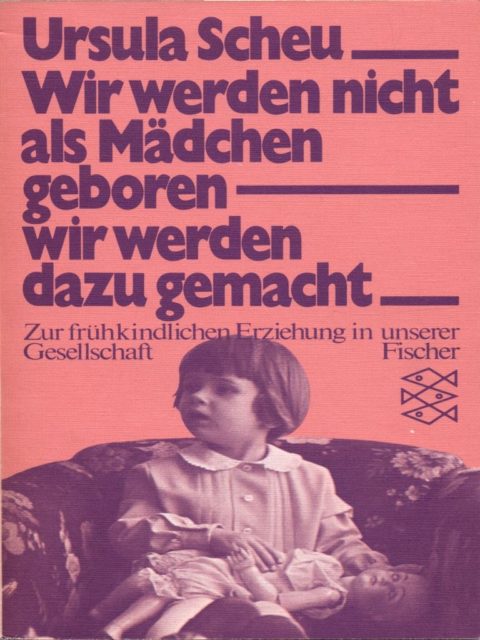
Already 70 years earlier, women’s rights activist Dr. Käthe Schirmacher states in her essay „Sexualism in Language„: „One only needs to study an organically grown, historically developed structure such as the everyday vernacular of ‚cultural countries‘ in order to see how strong sexualism is in this area too prevails. “ The book by Ursula Scheu: ‚We are not born girls, we are made to become ones‘ in published (in reference to the famous Beauvoir-sentence: „One is not born, but rather becomes, a woman“). In her analysis, the psychologist and co-founder of the Berlin women’s shelter demonstrates how girls (and boys) are forced into their gender role from birth: „The characteristics traditionally considered as feminine, such as motherliness, emotionality, social interest and passivity are not, of course, feminine and innate, but culturally educated.“ The book becomes a standard reading for psychology students.


